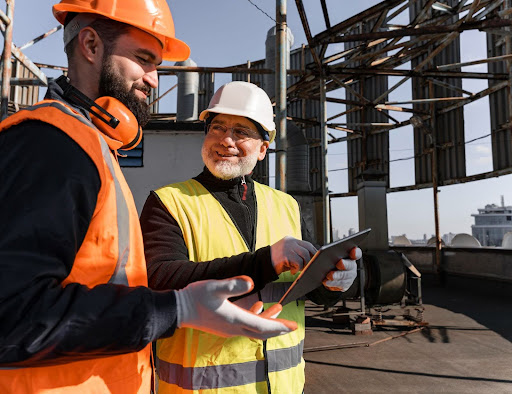.jpg)
Managing a construction crew across multiple job sites can feel strenuous. One worker might be late, another forgot to clock in, and someone’s coworker just clocked them in while they’re still stuck in traffic. Sound familiar? If you’re tired of dealing with manual timesheets and payroll headaches, it’s time to discover how geofencing is revolutionizing construction time tracking.

What Is Geofencing and How Does It Work?
Think of geofencing as an invisible fence around your job site. Using GPS technology or RFID signals, you create a virtual boundary that tracks workers' exact arrival and departure times. When someone with a GPS-enabled smartphone or tablet crosses that boundary, the system springs into action.
The beauty of geofencing time tracking is its simplicity. Your crew member drives onto the site, their phone detects they've entered the geofenced area, and voila—they're clocked in.
No paper timesheets to lose, no forgetting to punch in, and definitely no employee can clock in on behalf of another.
When they leave at the end of the day, the system automatically logs their departure. It's like having a digital supervisor who never sleeps and never makes mistakes.
These systems use mobile location tracking technology that works with regular smartphones, so you don't need to invest in expensive specialized equipment. The GPS time tracking happens in the background through an app that your workers install on their devices.
Why Construction Companies Are Making the Switch
Let's talk about the real problems that geofencing solves. Traditional construction time tracking methods are riddled with issues. Manual timesheets get lost, damaged, or filled out incorrectly. Workers sometimes round their hours up (or way up), and there's always that one person who asks their buddy to clock them in early.
With geofencing for employees, these problems disappear. The system creates an undeniable record of when someone actually arrived at the job site. You can't fake being somewhere when GPS coordinates say otherwise. This alone can save companies thousands of dollars in eliminated time theft.
But it goes way beyond just preventing fraud. Workforce attendance software powered by geofencing gives you real-time visibility into your entire operation. You can see at a glance who's on which site, who's running late, and who forgot to clock in.
This kind of transparency helps you make better decisions about scheduling, resource allocation, and project management.
The payroll benefits are massive, too. Instead of spending hours each week manually entering timesheet data and checking for errors, the attendance tracking via geofence feeds directly into your payroll system.
Many contractors report cutting their payroll processing time by up to 70 percent. That means your office staff can focus on more valuable work instead of being buried in spreadsheets.
Also Read: From Manual to Automated: Transforming Staff Payroll Management
Setting Up Geofencing for Your Construction Sites
Getting started with GPS time tracking for construction workers is more straightforward than you might think.
- Finding the right software: The first step is choosing the right software solution. You'll want to look for platforms that integrate smoothly with your existing payroll and project management systems.
- Setting up virtual boundaries: Once you've selected your platform, it's time to set up your virtual boundaries. Using a digital map interface, you'll draw perimeters around each of your job sites. These boundaries can be simple circles or complex polygonal shapes that match your actual site layout.
Got a sprawling commercial project with multiple zones? No problem. You can create overlapping geofences for different areas, assign them to specific project codes, and even set up restricted zones for hazardous areas.
The setup process typically involves entering your site address or GPS coordinates, adjusting the boundary size to capture the entire work area, and assigning relevant project codes or cost centers. For companies managing multiple sites, most platforms let you upload locations in bulk, which saves considerable time during the initial setup.

Getting Your Team Onboarded
The success of any new technology depends on user adoption, and geofence check-in systems are no exception. Your workers need to download the time tracking app on their smartphones or use company-provided tablets. The good news is that most modern apps are incredibly user-friendly and require minimal training.
Here's where communication becomes crucial. Some workers might feel uncomfortable with location tracking, worried about privacy, or constant monitoring. Be upfront about how the system works.
Emphasize that location tracking only happens during work hours and within job site boundaries. The system isn't following anyone home or tracking them on weekends. It's simply verifying that they're at the job site when they say they are.
Provide clear instructions on how to use the app, what to do if they forget their phone, and who to contact if technical issues arise. Consider running a pilot program with a small crew first, work out any kinks, and then roll it out company-wide with confidence.
Maximizing the Benefits of Geofencing
Once your system is up and running, you'll start seeing benefits immediately.
But to really maximize your investment, dig into the data your geofencing system provides. Most platforms offer dashboards showing real-time attendance, historical patterns, and detailed reports.
Use this information to identify trends. Are certain sites consistently experiencing late arrivals? Maybe there's a traffic issue you can work around by adjusting start times. Are workers frequently entering restricted zones? That might signal a need for additional safety training or better signage.
The job costing capabilities are particularly valuable. When labor hours are automatically matched to specific locations and project codes, you get accurate data on exactly how much each project phase costs in labor. This information helps you bid more accurately on future projects and identify where you're losing money.
Also Read: Why Accurate Attendance Tracking for Site Workers Is Crucial for Project Success
Compliance and Safety Advantages
Beyond time tracking, geofencing helps you maintain compliance with labor laws and safety regulations. The system creates detailed, timestamped records of when workers were on site, which becomes invaluable during audits or if wage disputes arise. For projects requiring certified payroll reporting or prevailing wage compliance, having accurate, automated records reduces your risk of costly penalties.
Safety managers love geofencing because it can restrict access to dangerous areas. Set up a geofence around a high-voltage zone or unstable structure, and the system alerts supervisors immediately if someone enters without authorization. This proactive approach to safety can prevent accidents before they happen.
Conclusion
Implementing geofencing for construction time tracking isn't just about adopting new technology—it's about fundamentally improving how you manage your workforce.
The combination of automated attendance tracking, reduced payroll errors, enhanced compliance, and better operational visibility creates a compelling case for any construction company looking to modernize their operations.
The initial setup requires some effort, but the ongoing benefits far outweigh the investment. You'll save time, reduce costs, improve accuracy, and gain insights that help you run a tighter, more profitable operation.
Curious to see how this works in real time? Book a demo today and experience firsthand how geofencing can reshape your workforce management.


.svg)



.png)
.png)


.svg)
.svg)
.svg)